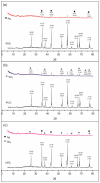Inhibition of the Growth of Escherichia coli and Staphylococcus aureus Microorganisms in Aesthetic Orthodontic Brackets through the In Situ Synthesis of Ag, TiO2 and Ag/TiO2 Nanoparticles
- PMID: 39203425
- PMCID: PMC11356132
- DOI: 10.3390/microorganisms12081583
Inhibition of the Growth of Escherichia coli and Staphylococcus aureus Microorganisms in Aesthetic Orthodontic Brackets through the In Situ Synthesis of Ag, TiO2 and Ag/TiO2 Nanoparticles
Abstract
Plaque control is especially important during orthodontic treatment because areas of the teeth near brackets and wires are difficult to clean with a toothbrush, resulting in debris buildup of food or dental plaque, thus causing caries and periodontal disease. The objective of this study was to evaluate the antimicrobial properties of silver nanoparticles (AgNPs), titanium dioxide nanoparticles (TiO2NPs), and silver/titanium dioxide nanoparticles (Ag/TiO2NPs), synthesized on the surface of α-alumina ceramic brackets. The AgNPs and TiO2NPs were synthesized by a simple chemical method, and these were characterized by XRD, SEM, and XPS TEM; the antimicrobial activity was tested against Staphylococcus aureus and Escherichia coli by diffusion test. The results of this study demonstrated that by this simple chemical method, silver and titanium dioxide nanoparticles can be synthesized on the surface of α-alumina esthetic brackets, and these NPs possess good antimicrobial activity and the possibility of reducing dental caries, periodontal disease, and white spot generated during orthodontic treatment.
Keywords: Ag; TiO2 and Ag/TiO2 nanoparticles; aesthetic orthodontic brackets of α-alumina; antibacterial effect.
Conflict of interest statement
The authors declare no conflicts of interest.
Figures








Similar articles
-
Bioactivation of an orthodontic wire using multifunctional nanomaterials to prevent plaque accumulation.Biomater Adv. 2023 May;148:213346. doi: 10.1016/j.bioadv.2023.213346. Epub 2023 Feb 16. Biomater Adv. 2023. PMID: 36963344
-
In vitro assessment of stainless steel orthodontic brackets coated with titanium oxide mixed Ag for anti-adherent and antibacterial properties against Streptococcus mutans and Porphyromonas gingivalis.Microb Pathog. 2017 Nov;112:190-194. doi: 10.1016/j.micpath.2017.09.052. Epub 2017 Sep 29. Microb Pathog. 2017. PMID: 28966064
-
Comparison of antibacterial activities of Ag@TiO2 and Ag@SiO2 core-shell nanoparticles.Spectrochim Acta A Mol Biomol Spectrosc. 2014 Jul 15;128:887-90. doi: 10.1016/j.saa.2014.02.063. Epub 2014 Mar 7. Spectrochim Acta A Mol Biomol Spectrosc. 2014. PMID: 24709355
-
Use of Antimicrobial Silver Coatings on Fixed Orthodontic Appliances, Including Archwires, Brackets, and Microimplants: A Systematic Review.Med Sci Monit. 2024 Jun 6;30:e944255. doi: 10.12659/MSM.944255. Med Sci Monit. 2024. PMID: 38843112 Free PMC article.
-
Green synthesis, characterization of silver nanoparticals for biomedical application and environmental remediation.J Microbiol Methods. 2022 Feb;193:106384. doi: 10.1016/j.mimet.2021.106384. Epub 2021 Nov 23. J Microbiol Methods. 2022. PMID: 34826520 Review.
Cited by
-
Exploring the Antibacterial, Antioxidant and Larvicidal Effects against Culex quinquefasciatus of Nigella sativa Seeds and its Silver Nanoparticles.Acta Parasitol. 2025 Jul 21;70(4):164. doi: 10.1007/s11686-025-01096-x. Acta Parasitol. 2025. PMID: 40690073
References
-
- Oves M., Rauf M.A., Aslam M., Qari H.A., Sonbol H., Ahmad I., Zaman G.S., Saeed M. Green synthesis of silver nanoparticles by Conocarpus Lancifolius plant extract and their antimicrobial and anticancer activities. Saudi J. Biol. Sci. 2022;29:460–471. doi: 10.1016/j.sjbs.2021.09.007. - DOI - PMC - PubMed
-
- Kamaruzaman N.H., Noor N.N.M., Mohamed R.M.S.R., Al-Gheethi A., Ponnusamy S.K., Sharma A., Vo D.-V.N. Applicability of bio-synthesized nanoparticles in fungal secondary metabolites products and plant extracts for eliminating antibiotic-resistant bacteria risks in non-clinical environments. Environ. Res. 2022;209:112831. doi: 10.1016/j.envres.2022.112831. - DOI - PubMed
-
- Linklater D.P., Le Guével X., Bryant G., Baulin V.A., Pereiro E., Perera P.G.T., Wandiyanto J.V., Juodkazis S., Ivanova E.P. Lethal Interactions of Atomically Precise Gold Nanoclusters and Pseudomonas aeruginosa and Staphylococcus aureus Bacterial Cells. ACS Appl. Mater. Interfaces. 2022;14:32634–32645. doi: 10.1021/acsami.2c04410. - DOI - PubMed
-
- Bilal M., Zhao Y., Rasheed T., Ahmed I., Hassan S.T., Nawaz M.Z., Iqbal H. Biogenic Nanoparticle–Chitosan Conjugates with Antimicrobial, Antibiofilm, and Anticancer Potentialities: Development and Characterization. Int. J. Environ. Res. Public Health. 2019;16:598. doi: 10.3390/ijerph16040598. - DOI - PMC - PubMed
LinkOut - more resources
Full Text Sources

